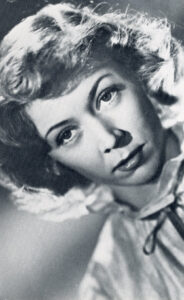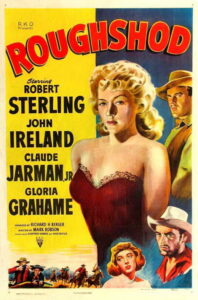Today is Gloria Grahame’s birthday. She would be 100 today, had she survived the breast cancer and peritonitis that killed her in 1981, so I thought I should take this opportunity to celebrate her glamorous, glorious cinematic career.
I first wrote about Gloria in the second print issue of Filmbobbery, back in August of 1999. I had always enjoyed her luminous presence and performances, in films ranging from the classic It’s a Wonderful Life (just her third film appearance) to The Man Who Never Was. When I determined to write that 1999 article about her I set out to watch as many of her films as I could, and I became so smitten by her that beautiful Gloria became the subject of my third book, eventually published in 2011.
Gloria was a fickle minx, a woman who could seem shy and insecure in demure roles, overtly sexual and predatory in others. Perhaps her most famous quote enlightened her unique sex appeal: “It wasn’t the way I looked at a man; it was the thought behind it.” She was at her best playing tough, independent women having difficulty staying out of trouble in the modern world, strong characters like Angel the elephant girl in The Greatest Show on Earth and the role that should have won a Best Actress Oscar for 1953, gangster’s moll Debby Marsh in The Big Heat. She is magnificent in that movie.
For a full decade, from 1946 through 1956, Gloria Grahame was a bona fide Hollywood star, with a spectacular roster of excellent performances in major films. These include Crossfire (her first Oscar nomination), Roughshod (an underrated western), In a Lonely Place (romancing Humphrey Bogart in style), Sudden Fear (menacing Joan Crawford in style), The Cobweb (instigating the battle over the draperies), Oklahoma! (delightfully playing against type as Ado Annie), The Man Who Never Was (persuading a German spy that a romantic ruse is genuine), The Bad and the Beautiful (her Oscar win), Song of the Thin Man (the final Nick and Nora Charles adventure), the aforementioned It’s a Wonderful Life and The Big Heat.
Even in her routine movies, things like Merton of the Movies, Naked Alibi, Macao, Human Desire, The Good Die Young, Not as a Stranger, A Woman’s Secret or It Happened in Brooklyn, she is memorable, sometimes spectacularly so. She was a very good actress and almost never gave a poor performance (Prisoners of the Casbah perhaps excepted). I was particularly impressed when she switched gears and deglamorized herself for the neorealistic drama The Glass Wall in 1953; I feel her sensitive performance as an ordinary woman caught up in an immigration drama is very powerful and affecting.
By 1957 her popularity had sagged, mainly through bad behavior on the Oklahoma! set, the weirdly-evolving appearance of her face, particularly her upper lip (a botched surgery) and personal scandal that at the time was not widely known by the public, but was certainly making the rounds in Hollywood circles. Following a few minor film roles in the late 1950s Gloria took to the stage, where she had begun, and spent the next decade making guest shots on television shows, touring in stage productions and raising a family. She kept in the public eye just enough to remind people that she was till around, and when she was ready for films again in the early 1970s she found work. Sadly, most of this work was in horror junk like Blood and Lace and Mansion of the Doomed, but the underrated true-crime story The Todd Killings is a highlight of that era.
A battle with breast cancer dominated the mid-1970s, but she still found time to appear in the smash television miniseries “Rich Man, Poor Man” and another the next year, “Seventh Avenue.” Gloria was more active as the decade ended, having a juicy role in Chilly Scenes of Winter (Head Over Heels) and an almost silent one in Melvin and Howard. Then cancer returned and Gloria ignored it, choosing to continue to work in movies and on stage until she couldn’t physically perform any longer. The Nesting, another gothic horror film, was her final film, although she also made a couple of “Tales of the Unexpected” episodes before she died shortly before her 58th birthday.
 I recently watched It’s a Wonderful Life again and was delightfully reminded how fresh and frisky Gloria is in that film. As Violet Bick, Gloria is the young woman every young man wanted to get to know, Donna Reed’s pretty Mary Hatch notwithstanding. She is similarly framed in Roughshod, the 1949 western in which she plays one of a quartet of dance hall girls run out of town by a progressive committee. Gloria’s character this time is Mary, a decent girl with dreams of gingham dresses and a family for which to care, forced by circumstance to make a living in a saloon. Gloria is so vivacious and smart and attractive in this western (filmed in 1947, held out of release for two years by Howard Hughes) that it is no wonder she is featured so fetchingly on the poster.
I recently watched It’s a Wonderful Life again and was delightfully reminded how fresh and frisky Gloria is in that film. As Violet Bick, Gloria is the young woman every young man wanted to get to know, Donna Reed’s pretty Mary Hatch notwithstanding. She is similarly framed in Roughshod, the 1949 western in which she plays one of a quartet of dance hall girls run out of town by a progressive committee. Gloria’s character this time is Mary, a decent girl with dreams of gingham dresses and a family for which to care, forced by circumstance to make a living in a saloon. Gloria is so vivacious and smart and attractive in this western (filmed in 1947, held out of release for two years by Howard Hughes) that it is no wonder she is featured so fetchingly on the poster.
Although Gloria became an even better, more proficient actress in the years to come, and found roles that allowed her to display her acting chops, it is the young, beautiful, fresh-faced Gloria that I like to remember when I think about her. As the pretty nurse who subtly inspires Frank Sinatra in the opening scene of It Happened in Brooklyn, or even Sally Murfin, the sexy ingenue of Blonde Fever (her first film, in 1944), where she teases Marshall Thompson and Philip Dorn to distraction. Roughshod is a nice mix for Gloria; her role of Mary is that of a woman who knows how to tantalize but doesn’t enjoy it much. She is more at home (and more attractive) in jeans and a flannel shirt, traveling and working outside, toward the goal of establishing a home for herself.
By contrast, her sexpot roles in The Good Die Young, Naked Alibi and Not as a Stranger are certainly flamboyant and exciting, but I prefer the more naturally demure Gloria. I may be in the minority here, and that’s okay. Enjoy her as you wish.
I missed an opportunity to see her, and possibly meet her, in 1980, when I was in college. She happened to be appearing at another nearby college in a stage production of Macbeth, and, had I known about it at the time, I would no doubt have made the effort to see her in person. By then I was the editor of our college paper and had met and interviewed visiting celebrity guests to our campus like John Houseman and Nicholas Pennell. Knowing who she was, and having recently reviewed recent movies of her in our paper, I absolutely would have tried to gain an audience with her. The lesson here: pay attention to the world around you and be ready to grab an opportunity when it presents itself. Gloria died the very next year.
My 1999 article spotlights what I felt were Gloria’s five best performances. They were: #5, The Cobweb; #4, The Bad and the Beautiful; #3, The Greatest Show on Earth; #2, In a Lonely Place; and #1, The Big Heat. Those are good, strong choices, although now I might move The Glass Wall into the fourth or fifth slot. Gloria won a Supporting Actress Academy Award for The Bad and the Beautiful and was similarly nominated for Crossfire, but she deserved it for The Big Heat in 1953 and wasn’t even nominated. As for the best films in which Gloria ever appeared, it’s hard to argue against It’s a Wonderful Life and The Bad and the Beautiful, both four-star classics. Runners-up would be In a Lonely Place, The Big Heat, Crossfire, The Man Who Never Was, Odds Against Tomorrow and Melvin and Howard. All in all, she had quite a good career.
Except for the perennial holiday favorite, It’s a Wonderful Life, modern audiences don’t really know about Gloria Grahame. This month Turner Classic Movies has shown quite a few of her movies, especially today, and that helps, but that only goes so far. A few years ago Gloria was portrayed (pretty well) by Annette Bening in the biopic Film Stars Don’t Die in Liverpool, which chronicled the last few weeks of Gloria’s life, in England (she was flown back to New York and lasted but a few hours before succumbing to peritonitis). But no biopic will ever do justice to the actual Gloria, the stylish and beguiling actress who got her start at Hollywood High and made it all the way to major stardom some seventy years ago. At least her many movie performances remain to bear witness to her talent and appeal. I fell in love with her years ago, and I am not alone. Bless you, Gloria Grahame, and thank you for sharing yourself with us so long ago.
